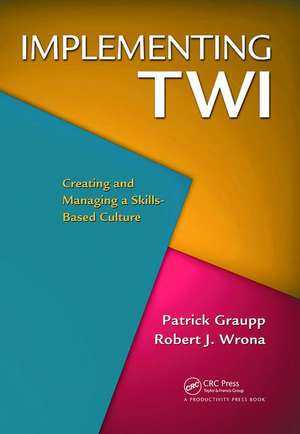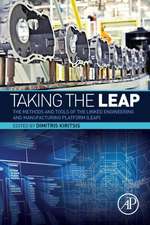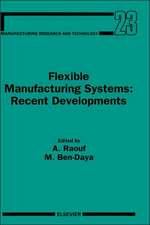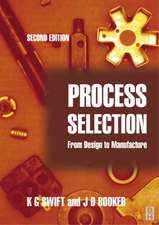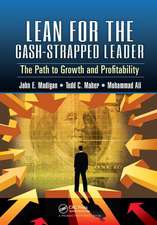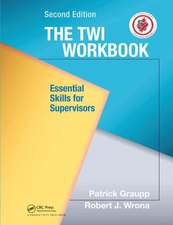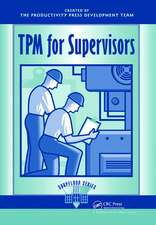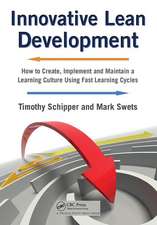Implementing TWI: Creating and Managing a Skills-Based Culture
Autor Patrick Grauppen Limba Engleză Hardback – 28 iun 2018
Preț: 1000.70 lei
Preț vechi: 1336.95 lei
-25% Nou
Puncte Express: 1501
Preț estimativ în valută:
191.48€ • 199.92$ • 158.48£
191.48€ • 199.92$ • 158.48£
Carte tipărită la comandă
Livrare economică 04-18 aprilie
Preluare comenzi: 021 569.72.76
Specificații
ISBN-13: 9781138438828
ISBN-10: 1138438820
Pagini: 500
Dimensiuni: 178 x 254 mm
Greutate: 1.22 kg
Ediția:1
Editura: Taylor & Francis
Colecția Productivity Press
Locul publicării:Oxford, United Kingdom
ISBN-10: 1138438820
Pagini: 500
Dimensiuni: 178 x 254 mm
Greutate: 1.22 kg
Ediția:1
Editura: Taylor & Francis
Colecția Productivity Press
Locul publicării:Oxford, United Kingdom
Public țintă
Professional Practice & DevelopmentRecenzii
Graupp and Wrona have been teaching and implementing the tools of TWI for years in many different types of companies … . If you want to get from interesting displays to true standardized work, read this book.
—Jeffrey K. Liker, Shingo Prize-Winning Author of The Toyota Way
… explains why TWI is a basic building block for converting an organization that has engineered Lean into a learning organization … . uses cases to explain how to create no-nonsense culture change by teaching people how to do work differently, and how to relate to each other differently in order to work more effectively.
—Robert "Doc" Hall, Editor-in Chief, Target Magazine, author of Compression: Meeting the Challenges of Sustainability Through Vigorous Learning Enterprises
Graupp and Wrona … not only explain the lessons learned … but further clarify the integration needed to develop a strategic success between TWI and other core functions of any business.
—Jim Huntzinger, Founder and President, Lean Accounting Summit, TWI Summit, and Lean and Green Summit
If companies are serious about developing skills and making improvements then I urge them to study up on TWI concepts.
—Art Smalley, President, Art of Lean, and Shingo Prize-Winning Author
… Graupp and Wrona bring many examples of companies that [improved] competitiveness by improving their capacity to fully engage their workforce …
—Steven Spear, author and Sr. Lecturer, MIT Sloan School of Management
—Jeffrey K. Liker, Shingo Prize-Winning Author of The Toyota Way
… explains why TWI is a basic building block for converting an organization that has engineered Lean into a learning organization … . uses cases to explain how to create no-nonsense culture change by teaching people how to do work differently, and how to relate to each other differently in order to work more effectively.
—Robert "Doc" Hall, Editor-in Chief, Target Magazine, author of Compression: Meeting the Challenges of Sustainability Through Vigorous Learning Enterprises
Graupp and Wrona … not only explain the lessons learned … but further clarify the integration needed to develop a strategic success between TWI and other core functions of any business.
—Jim Huntzinger, Founder and President, Lean Accounting Summit, TWI Summit, and Lean and Green Summit
If companies are serious about developing skills and making improvements then I urge them to study up on TWI concepts.
—Art Smalley, President, Art of Lean, and Shingo Prize-Winning Author
… Graupp and Wrona bring many examples of companies that [improved] competitiveness by improving their capacity to fully engage their workforce …
—Steven Spear, author and Sr. Lecturer, MIT Sloan School of Management
Notă biografică
Patrick Graupp, Robert J. Wrona
Cuprins
Foreword, Acknowledgments, Introduction: A Compelling Need for Skill, Training, Section I TWI Takes Hold in the US—Again, Section II TWI’s Connection to Lean, Section III TWI and Culture, Section IV TWI Implementation, Section V Expanding TWI by Leveraging JR, JI, and JM, Index, About the Authors
Descriere
Written by two experts who have dedicated their careers to quality improvement, Escape the Improvement Trap: Five Ingredients Missing in Most Improvement Recipes separates itself from other improvement books by looking at why most companies rarely achieve anything more than an average level of improvement maturity. They identify five critical ingredients required for successful improvement:1. A meaningful business value proposition and strategy that drives key improvement actions2. An engaging environment where people can do their best work3. A focus on meaningful metrics while avoiding irrelevant details4. Process improvement efforts that maximize cross-functional process performance and foster deeper process understanding, innovation, and execution of best work practices5. An executive mindset that focuses on customer value, people development, process performance, and business improvement outcomes, not solely on savingsThe authors consider a variety of situations at Independence Enterprise, a fictional company, based on their own very real experiences. They elaborate on the principles that should come into play, look at what Independence Enterprise is doing right and wrong, and suggest deployment actions to help you apply the principles to your own organization.
